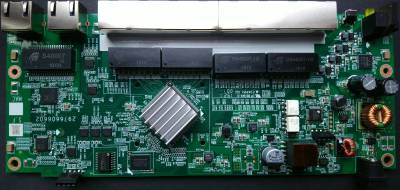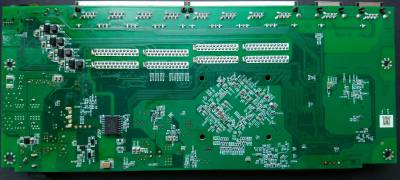Netgear GS110TPP
The GS110TPP is a 10-port managed gigabit switch. Eight ports support PoE+, with a standard total power budget of 120W.
Hardware build-up
- RTL8380M SoC
- Macronix MX25L25635F (32MB flash)
- Winbond W631GG8MB (128MB DDR3 SDRAM)
- RTL8214C external PHY
- RTL8231 GPIO extender
- Nuvoton M0516LDN microcontroller (SoC-PoE management)
- Broadcom BCM59121 (PoE controller)
To access the CPU's serial console on UART0, header J1 is available with 3.3V logic, 115200 baud, and 8n1 bits.
The internal switch connects to port 1-8, while the external phy connects to port 9-10. The external phy is linked to the SoC via a QSGMII link.
Ports 1-8 can also provide power according to 802.3.at (PoE+) and PoE is controlled by the BCM59121. PoE management is done by an auxiliary Nuvoton M0516LDN microcontroller. Communication with the Poe-CPU happens via a serial port, connected to the main CPU's UART1. Optocouplers are used to isolate the two circuits from each other and the communication frames can be sniffed from J3 (3.3V, 19200 baud, 8n1).
To indicate the global device status, two LEDs are present on the front panel. One is labelled 'PoE Max', and is controlled directly by the PoE MCU. The other is labeled 'Power', and is used to indicate the device status. This LED a three-component RGB LED, driven by thre individual GPIO lines of the RTL8231. All ports have a two-pin bi-color LED, used to indicate the link status: green for 1000M, orange for 100M. These are driven by three SN74HC164 shift registers, using 20 of the 24 outputs available. PoE status bi-color LEDs are also available, with green used to indicate the remote device is PoE powered, and orange to signal a PoE fault status. The PoE-status LEDs are driven by two SN74LV595A shift registers, also controlled by the PoE MCU.
A SN74LVC125A four-port tri-state buffer is used to for the reset signal fan-out, driven by internal GPIO13 (TP7).
Board pictures
GPIO connections and port LEDs
- Internal GPIO connections:
- GPIO0: connected to front panel reset button. Input, active low.
- GPIO2: connected to clock line of RTL8231. Output, used by MDIO/SMI peripheral (or bit-banged MDIO)
- GPIO3: connected to data line of RTL8231. Input/output, used by MDIO/SMI peripheral (or bit-banged MDIO)
- GPIO13: connected to #RESET pin of SoC (114). Output, active low, external pull-up. Also resets the RTL8214C phy and the LED shift registers via the SN74LVC125A four-port buffer.
- RTL8231 GPIO connections:
- GPIO10: PoE enable line, active high.
- GPIO31, GPIO32, GPIO34: red, green, and blue components of the "Power" RGB LED. Output, active low.
- Port LED:
- Port 0-23, LED0: Green LED, link/act 1G
- Port 0-23, LED1: Amber LED, link/act 100M/10M
- "PoE Max" LED is controlled by the PoE MCU
Pinouts
GPIO
- TP8: GPIO1
- TP3: GPIO14
- TP4: GPIO11
- TP5: GPIO10
- TP6: GPIO12
- TP7: GPIO13
I2C
- TP1: CLK
- TP2: DAT
JTAG
- TP3: #TRST
- TP4: TDI
- TP5: TDO
- TP6: TMS
- TP7: TCK
MDIO
- Between R163/C41: MDIO
- Between R165/C43: MDC
Serial console
- J1.1: 3.3V via R9 (not populated)
- J1.2: RX
- J1.3: TX
- J1.4: GND
Serial PoE control
This connector is in the PoE power domain, which is isolated from the power domain of the SoC. Be careful when connecting to this port and use a digital isolator.
- J3.1: VCC (appears not connected)
- J3.2: RX
- J3.3: TX
- J3.4: GND
Firmware
| Flash layout | |||||||
|---|---|---|---|---|---|---|---|
| Name | u-boot | u-boot-env | device-info | config | log | firmware1 | firmware2 |
| Size | 896k | 64k | 64k | 1M | 1M | 14.5M | 14.5M |
Vendor board definition
------------------ Board Configuration ------------------ *********************************************************** GS110TPP 8-Port Gigabit PoE+ Ethernet Smart Managed Pro Switch with 2 Copper Ports and Cloud Management *********************************************************** ============================ Board GPIO ============================ Device Pin Direction Default Current ------- ---- ---------- -------- -------- INT 0 IN 0 1 INT 13 OUT 1 1 EXT 4 IN (IN ) 0 0 EXT 6 IN (IN ) 0 0 EXT 7 IN (IN ) 0 0 EXT 10 OUT (OUT ) 0 1 EXT 11 IN (IN ) 0 0 EXT 12 IN (IN ) 0 0 EXT 13 IN (IN ) 0 0 EXT 14 IN (IN ) 0 0 EXT 20 OUT (OUT ) 1 1 EXT 24 OUT (OUT ) 1 1 EXT 25 OUT (OUT ) 1 1 EXT 27 OUT (OUT ) 0 0 EXT 28 OUT (OUT ) 0 0 EXT 31 OUT (OUT ) 1 1 EXT 32 OUT (OUT ) 0 0 EXT 34 OUT (OUT ) 1 1 ============================ Board Configuration ============================ ====== Port ================== Type Usr Phy Media Speed Duplex Attr ----------- ---- ------- ----------- -------------- -------- ------- 1000M 1 (0) 8 Copper (A) ALL Auto 1 1000M 2 (0) 9 Copper (A) ALL Auto 1 1000M 3 (0) 10 Copper (A) ALL Auto 1 1000M 4 (0) 11 Copper (A) ALL Auto 1 1000M 5 (0) 12 Copper (A) ALL Auto 1 1000M 6 (0) 13 Copper (A) ALL Auto 1 1000M 7 (0) 14 Copper (A) ALL Auto 1 1000M 8 (0) 15 Copper (A) ALL Auto 1 1000M 9 (0) 16 Copper (A) ALL Auto 0 1000M 10 (0) 17 Copper (A) ALL Auto 0 ====== Button ================ ------------ Reset Button GPIO: INT_0 Timer: 2(sec) Action: Reboot Timer: 5(sec) Action: Restore Factory ====== Led =================== System ON [CUSTOM] ON C2 [CUSTOM] OFF [CUSTOM] Port ON [ASIC(P)] ON C2 [ASIC(P)] OFF [ASIC(P)] AUTO [ASIC(P)] PoE Max ON [MCU] OFF [MCU] AUTO [MCU] PoE Port ON [MCU] ON C2 [MCU] OFF [MCU] AUTO [MCU] Cloud ON [CUSTOM] OFF [CUSTOM] ====== Reset ================= Type: GPIO GPIO: INT_13 ====== WatchDog ============== Type: REG ====== PoE ===================
Bootloader
U-Boot is used as bootloader for this device, and has access to a modifiable u-boot-env partition. This can be used to store modified and custom environment variables.
Some realtek-specific commands are also available:
rtk network on: Configure the ethernet hardware inside the bootloader (not enabled on boot).

